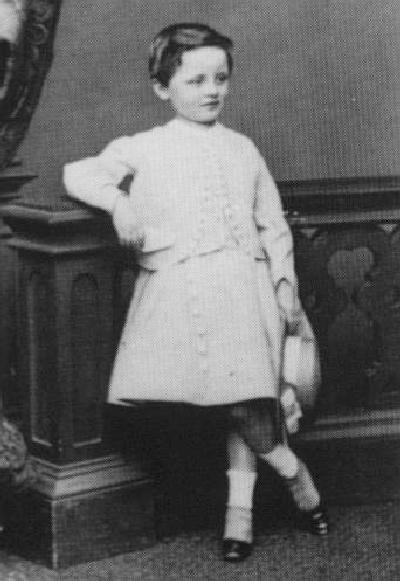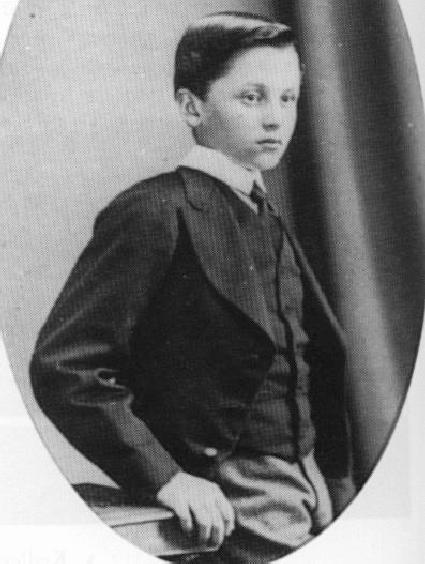
Figure 1.--This portrait of the future Lord Curzon was taken in 1865. George was 6 years old at the time and wears a white or light-colored kilt suit.


Figure 1.--This portrait of the future Lord Curzon was taken in 1865. George was 6 years old at the time and wears a white or light-colored kilt suit. |
George Curzon was the eldest son of Baron Curzon. He was perhaps the most impportant British politican in modern times that failed in his quest to become prime minister. He was born in 1859 and proved to be a brilliant
student. Curzon was an ambitious man who tended to see issues in stark terms. He took strong positions and would rarely acknowledge any middle ground. He became a force in the Conservative Party and served as Viceroy of India. He introduced reforms angering Lord Kitchner--head of the British Army in India. He was at the time a firm believer in Empire and Britain's imperial mission. Interestingly, today he is chiefly remembered for extending Western knowledge of Indian art, archeology, and literature. Before and after World War I, he led the fight against womens' suffrage which is part of the reason he never achieved his goal of becoming primeminister.
George Nathaniel Curzon was the eldest son of Baron Curzon. He was born in 1859.
We have no information about George's childhood at this time.
George's hair was cut short even before he was breached as can be seen in the portrait of him in his kilt suit (figure 1). I'm not sure just when his hair was first cut. It is only slightly shoulder when he was photographed at age 12 in a suit (figure 2).
George at age 6 is weating a kiltsuit (figure 1). He seems to be wearing a cream colored short length jacket in the Fauntleroy style with many buttons along the front on both sides but only the top button is closed. The image is difficult to determine. Beneath the long sleeve jacket which may have some cuff trims he wears a band collared blouse. The manner in which it billows out at the bottom hem suggests a blouse. The kilt skirt has two rows of buttons along the front. The kilt descends to just below his knees. He wears white anklets with spats and what may be patent leather black shoes. His straw hat has a streamer and fancy back bow. He appears rather confident in the picture!
In the second portrait he wears a short, dark jacket with grey trousers. The collar is rather small, certainly not an Eton collar. The outfit looks in someways similar to the Eton College uniform for new boys, but it was in fact his prep school uniform. This shows how important Eton was, inflencing the uniform of bpth prep schools and other public schools. George was only 12 when the portrait was taken so this would have been his last year at prep school and he was preparing to enter Eton. The prtrait shows that boys at his prep school wore Eton suits. It is an interesting image, depicting him in an earlier type of Eton collar which was rather less deep than the classic style which reached its apogee in the early 1900s. One imagines that the type worn by Curzon was rather more comfortable than the deeper collars which became fashionable in subsequent decades.

Figure 2.--Curzon is pictured here at 12 years of age in 1871. He was about to begin his studies at Eton College. He was a brilliant student. |
George was a brilliant student. He attended the prestigious Eton public (private) school. At Eton College he won a record number of academic prizes. He entering Oxford University in 1878. He was elected president of the Oxford Union in 1880--a considerable honor. Although George did not earn a first he was made a fellow of All Souls College in 1883.
Curzon like most artistocrats supported the Conservative Party. Curzon served as private secretary to the new prime minister Lord Salisbury in 1885, eginning a close personal association. The party allowed him to run for parliament at the safe Tory (Conservative) seat for Southport in 1886. As a new member of parliament (MP), however, Curzon rather neglected his parliamentary duties. Instead he chosen to travel extensively around the world. He visited India, the jewel in the crown of te Britisj Empire, several times. He also visited Ceylon, Afghanistan, Persia, Turkistan, China, Japan and Korea. These travels provided material for a series of books that were widely read at the time, describing his travels and political views. These included: Russia in Central Asia (1889), Persia and the Persian Question, (1892) and Problems of the Far East (1894). These books built a reputation for Curzon as a expert in Asian affairs. Curzon was the archetypal Edwardian establishment figure. There was a famous ryme at the time, "My name is George Nathaniel Curzon,
I am a most superior person, My cheek is pink, my hair is sleek,
I dine at Blenheim once a week." I'm not sure who penned it.
Curzon's youngest daughter was Lady Alexandra Metcalfe. Another daughter, Lady Cynthia, was Sir Oswald Mosley's first wife.
The Marquis of Salisbury in November, 1891, appointed Curzon as his secretary of state for India. Curzon lost this post when Earl of Rosebery formed a Liberal Government in 1894. The General Election of 1895 returned the Conservative Party to power. Curzon was given the post of under secretary for foreign affairs. Three years later the Marquis of Salisbury granted him the title, Baron Curzon of Kedleston, and appointed him Viceroy of India. Once in India, Curzon introduced a series of reforms that upset the British his civil serice in India. He also angered Lord Kitchener, who had became the comander of the Indian Army in 1902. Lord Curzon was one of the most important English Viceroys. He was a seasoned politician and very young, only about 40 at the time of his appoinment. He was both energetic and capable. His understanding of the Asian affairs was better than that of other British statesman of the time. He understood Indian problems and addressed most of them. His goal was to strengthen British Empire
in India. The reforms were very extensive, much to popular to asess in ant detail here. Many such as measures to deal with plague and to potect famers were of grea benefit to Indians. A meaure to divide Bengal proved very unpopular. He was at the time a firm believer in Empire and Britain's imperial mission. Interestingly, today he is chiefly remembered for extending Western knowledge of Indian art, archeology, and literature. One of hisreforms was to preserve Indian archeologiucal trasures. His many reforms disturbed many British leaders who chief interest was to mainain th established order with a minimuum of local unrest. The new leader of the Conservative Party, Arthur Balfour, began to qestion Curzon's judgement. Curzon in 1905 was forced out of office.
Curzon returned to England in 1905 and decided to lead the campaign against women's suffrage in the House of Lords. He helped establish the Anti-Suffrage League in 1908 and eventually became its president.
The new prime minister, David Lloyd George, in 1916 invited Curzon to join the War Cabinet. Curzon served as leader of the House of Lords during the rest of the War. He refused, however, to support the Government's decision to introduce the Qualification of Women Act in 1918. Despite Curzon's objections, it passed in the House of Lords by an overwealming vote of 134 votes to 71.
Curzon was appointed foreign secretary in 1919. He played a mnajor role in negotiating the transfer of populations between Greece and Turkey that followed the failed Greek offensive in Anatolia after World War I. When Andrew Bonar Law resigned as prime minister in May, 1923, Curzon was expected to become the new prime minister. Curzon was, however, understandably not popular with the new women voters. It was Stanley Baldwin who gained the appointment instead. Curzon was biteraly disappointed. He continued as foreign secretary until retiring from politics in 1924. He died in 1925.
Navigate the Boys' Historical Clothing Web Site:
[Return to the Main biography page]
[Return to the Main biography C page]
[Return to the Main Irish page]
[Introduction]
[Activities]
[Biographies]
[Chronology]
[Clothing styles]
[Countries]
[Bibliographies]
[Contributions]
[Essays]
[FAQs]
[Glossaries]
[Satellites]
[Tools]
[Boys' Clothing Home]
